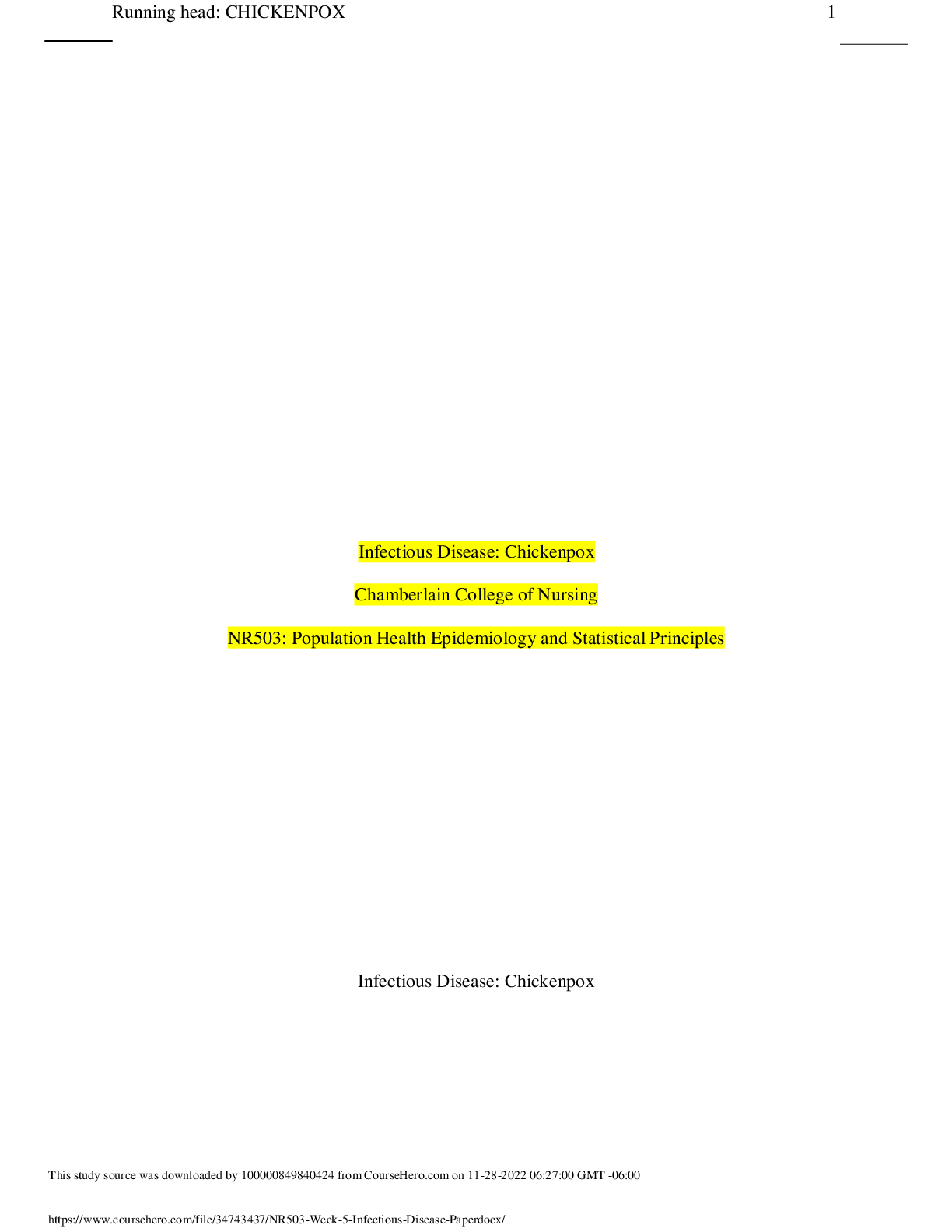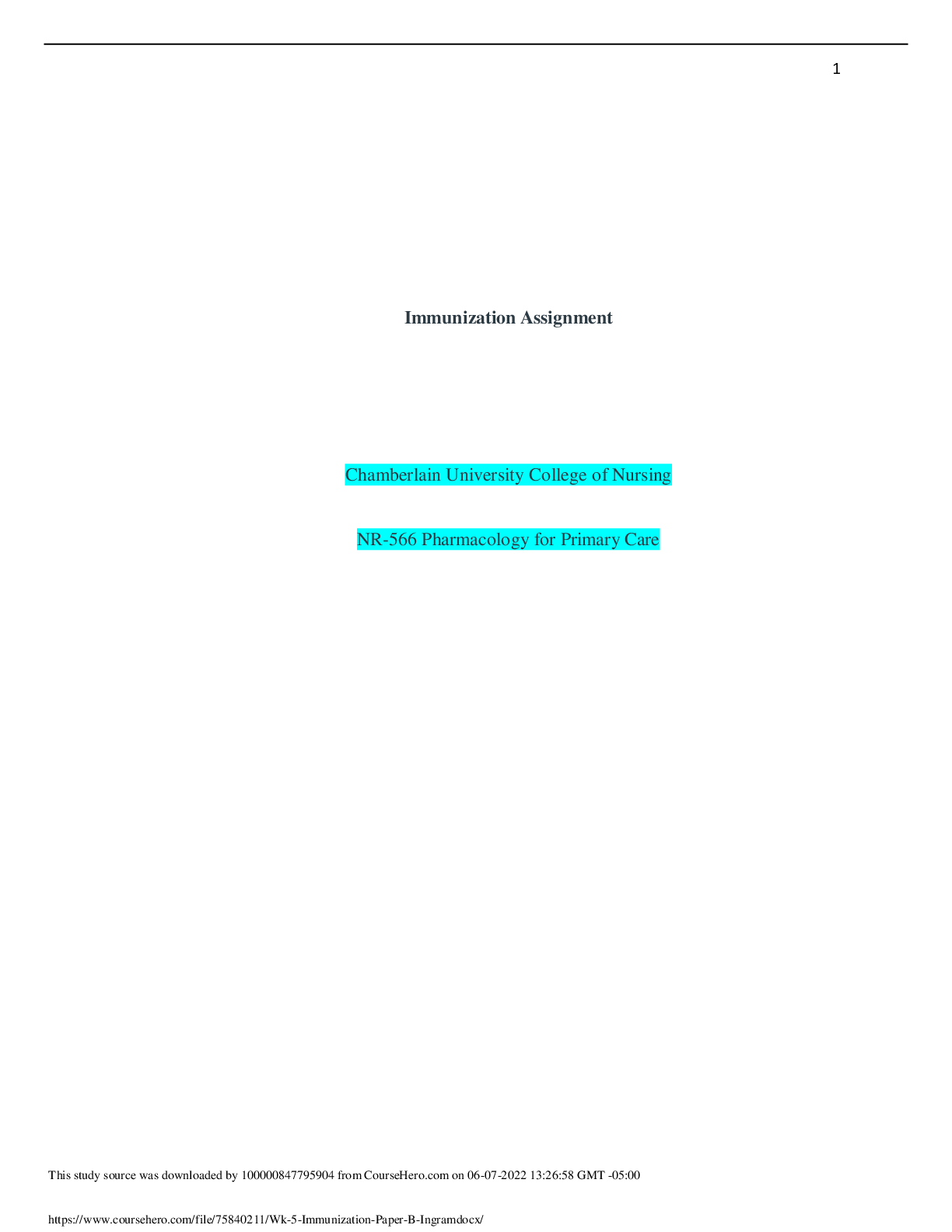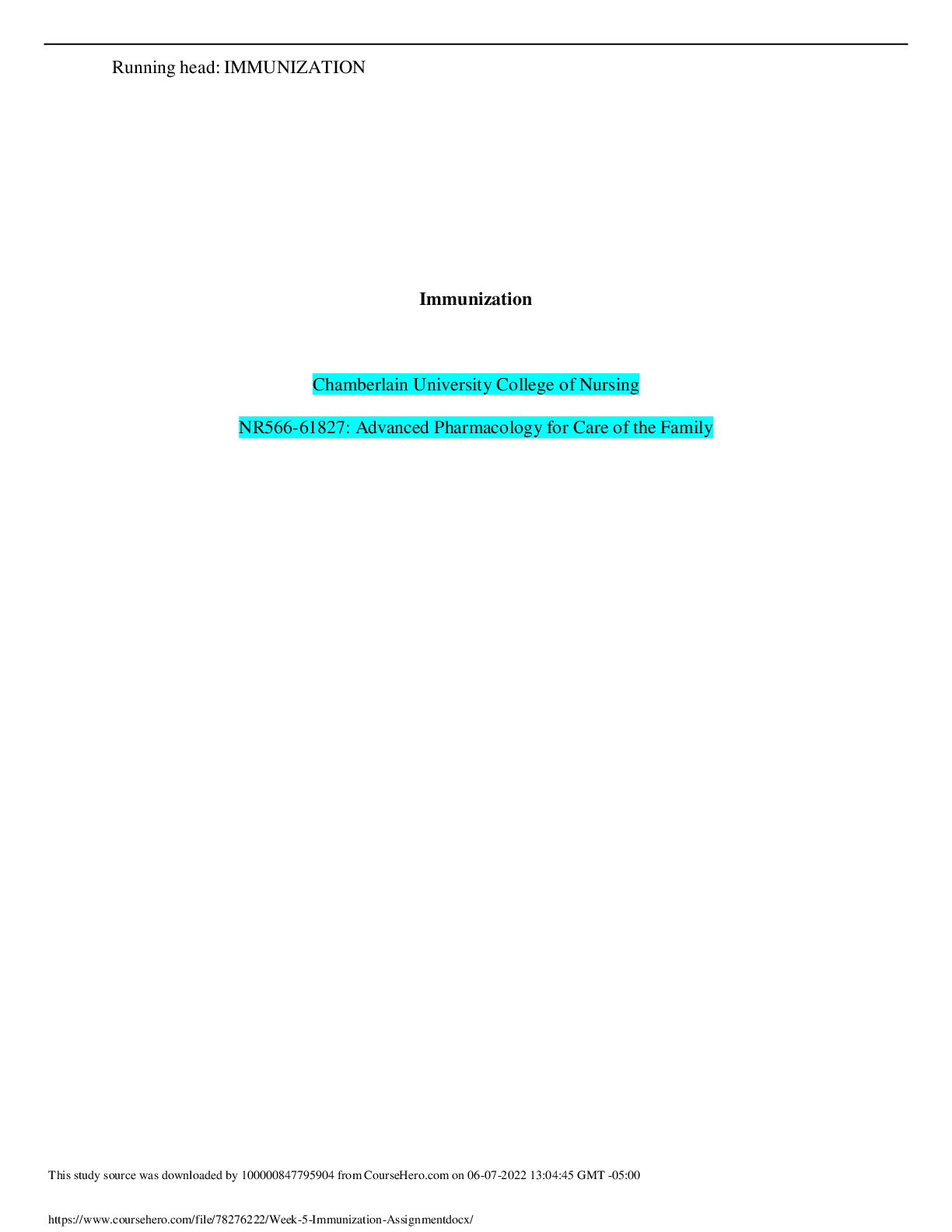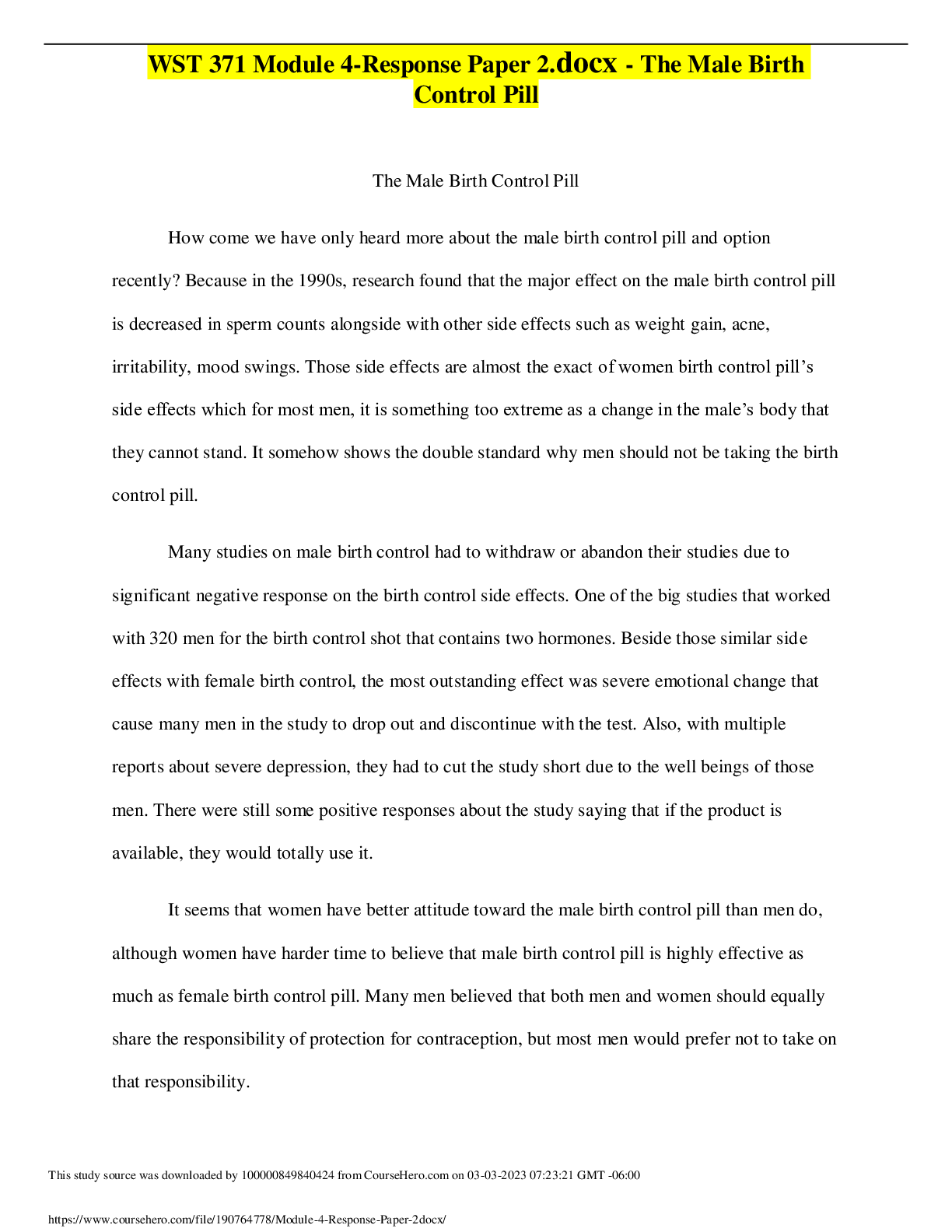*NURSING > ESSAY > NR-509 Week 4 Alternative Writing Assignment: Assessment of the Heart. 100% CORRECT. (All)
NR-509 Week 4 Alternative Writing Assignment: Assessment of the Heart. 100% CORRECT.
Document Content and Description Below
Alternative Writing Assignment Chamberlain College of Nursing NR 509 Advanced Physical Assessment Introduction The body has various body stems that facilitate its proper functioni... ng. This paper will investigate on the circulatory system. The system is also known as the cardiovascular system and its main purpose is to carry blood around the body. Blood is a very important element when since it distributes substances required for normal bodily function and excretes substances no longer required by the body to the various excretion organs and tissues. This paper provides a synopsis of this important body system. It is a system that sustains life. A deeper understanding of the circulatory system is critical to appreciating its functions as well as the numerous circulatory system elements, for example, its paths including veins, arteries, and capillaries. The reason why caregivers have to understand this system is that it enables the provision of safe and efficient care which improves patient outcomes. Physiology Multicellular beings have established transportation and circulatory systems whose purpose is to distribute oxygen and other nutrients to cells while simultaneously removing carbon dioxide and other metabolic wastes. The main organs that comprise the circulatory system include respiratory organs for example the lungs and heart and these organs are directly involved in the intake and exhalation of oxygen. Still, there are other systems that support the cardiovascular system, for example, the lymphatic system (Longdom.org n.d.). This system extends from the human circulatory system that comprises of binaries for instance cell and antibody-mediated immune structures. In human beings, the circulatory system's role is to carry blood rich in oxygen beginning at the lungs to the other bodily organs. The heart plays a central part in pumping the blood to every part of the body. For all living organisms, the ability to transport nutrients and waste to and from all cells respectively is essential. For single-celled beings, circulatory systems are unnecessary since nutrient exchange occurs at their cell surface. The major elements of the human cardiovascular system also include blood cells and the pathways followed by blood and air. Oxygen and carbon dioxide swap happens in the lungs to and from the blood respectively. The path followed next is towards the heart by means of the pulmonary vein where the blood is now pumped it to various parts of the body to facilitate metabolic processes. Blood rich in oxygen is known as oxygenated blood. During the process of cell metabolism, oxygen is used up and carbon dioxide released. Blood with depleted oxygen levels is transported back to the heart. The next stop for the deoxygenated blood is the lungs to where oxygenation process is initiated. The gas exchange in the lungs would not be possible without inhalation and exhalation processes. Inhalation allows intake of air via either the nose or the mouth and into the lungs via the trachea and its left and right branches, the bronchi. The bronchi’s interior is lined with structures biologically referred to as cilia and they facilitate filtering of foreign material from the respiratory system. The terminal ends of both bronchi connect to the lungs’ lobes which in turn have structures called alveoli attached to them. This is where exchange of gases happens. Mucus can also be found in the respiratory system and the mucous role is to collect dust, bacteria, and other foreign material, hence preventing the foreign materials from entering the lungs. And can be expelled from the body via mechanisms such as sneezing and swallowing. Health History Questions A thorough and comprehensive clinical assessment is vital in order to evaluate the probable cause and severity of cardiovascular disorder’s signs and symptoms, assemble suitable examinations and referrals, and prevent avoidable assessments while assessing a person’s risk of cardiovascular disease. The first step is normally to evaluate the health history of the patient. The objective of obtaining the cardiovascular system health history of the patient is to get information as regards the patient’s previous cardiovascular symptoms, conditions, and causes. As a healthcare provider, a total cardiovascular history provides critical information as regards to potential or underlying cardiovascular conditions. It is a guiding framework for possible physical exams. Besides, the subjective question provides data about other factors that affect the physical status of the patient which includes spiritual needs, cultural eccentricities, as well as functional living status. When presenting the problem, the healthcare provider can ask a number of critical. The healthcare provider can ask the reason the patient seeks medical attention. Commonly, patients have more than one issue they would love addressed. Personal concerns should, however, be raised later, after addressing the primary concerns. Some examples of questions the caregiver can ask to include: Why did the patient seek medical attention? What signs and symptoms are evident? How long have the symptoms manifested themselves and does the patient feel any sort of pain? What makes the symptoms severe or what makes them less severe? Is the patient using any form of medication? Examination Physical examination is a common method of diagnosis. During the physical examination, the caregiver must take into account various elements associated with cardiovascular condition. The elements include palpations, chest pains and breathing rates (O’Gara and Loscalzo n.d.). Palpation involves examining the respiratory path. The examiner should note that it occurs at the midline. Palpation of both anterior and posterior chest section is normally done using the care giver’s palms. A good result should indicate a tender chest with minimal chest discomfort and no visible palpable masses. If the care giver discovers a crackling feeling to the skin it could be a sign that subcutaneous emphysema/crepitus exists meaning the patient air has leaked to the subcutaneous tissue. Tactile fremitus is another condition physical examination determines by physically evaluating the intercostal spaces. Percussion of the chest wall is another critical physical test. The less dominant hand’s middle finger is pressed by the examiner’s dominant mid finger, and signs for instance dullness, tympani, as well as hyper resonance. Dullness could be a sign fluid has accumulated leading to pneumonia. Hyper resonance may be a result of over-inflated lungs such as those in the case of patients suffering from chronic obstructive pulmonary condition. Additionally, during respiratory assessment the examiner performs lung field’s auscultation. The patient should be sitting upright and the examiner should ask the patient to engage in deep mouth inhalation and exhalation exercises to properly aerate lung fields, an important process during auscultation process. A stethoscope should help the examiner observe the top of the lungs and then listen to activities on the side up to the lung’s bases, before repeating the process again. The process is effective if it is done both anteriorly and posteriorly. The humming noises of the lung fields are vesicular breath sounds. Bronchial sounds are heard over the bigger airways and listening via the trachea. The examiner should be auscultating for any strange lung noises in all the fields. Crackles are the lung sounds produced by fluids in the lung which could be indicative of an infection such as pneumonia or fluid overload such as pulmonary edema. Wheezing is a musical sound that is often heard when there is bronchial constriction secondary to asthma or another reactive airway disease. Rhonchi sounds are as a result of accumulation of fluids in the tapered bronchi paths which causes a coarse rattling sound to be heard. Stridor is a high-pitched sound that is indicative of a medical emergency because it is usually secondary to partial airway obstruction. Special Physical Assessment Procedures The approach to physically examining a patient suspected circulatory conditions starts evaluation of directed history and is followed by a physical examination. The span of the initiatives is based on the healthcare setting at the time of the patient’s evaluation, and includes elective ambulatory follow-ups to advanced emergency department encounters (Newson 2016). Special physical examination procedures can be applied. A good example is Spirometry, a trial that is conducted in the healthcare setting. The test assesses the patient’s inspiratory-expiratory capacity. It is important because it is used in the assessment of circulatory issues, for instance, asthma. Through the spirometry assessment, the care givers determine how effective a treatment regimen is. The test is not only cost-effective, but it assists in lessening patient delays when the patient visit testing centers (Coates, Tamari, & Graham, 2014). Often, patients may not comply with care modalities since some are inconvenient. Utilizing these techniques in the setting improves patient experiences, outcomes as well as enhances compliance to care modalities instituted in the primary care setting. Adaptation of the Physical Assessment Special populations for example infants, pregnant women, and geriatric adults must be examined using refined techniques to get important data during the diagnosis process. When evaluating an infant’s history, the infant’s parents provide the main historical information meaning the caregivers ought to build a proper relationship with parents/guardians. The answers to questions associated with previous cases of respiratory problems for example, cyanosis, , the home setting, and any other relevant information is important. Also, the parents provide an analysis of whether previous medications were effective. Another critical population is pregnant women. Pregnancy normally does not directly impact the circulatory system (LoMauro and Aliverti 2015). However, pregnancy sometimes causes women to be in a hypercoagulable state which exposes them to the risk of acquiring deep vein thrombosis and later on it evolves to pulmonary embolism. Pregnancy is a delicate situation and care givers are careful with the modalities of their treatment, to ensure only treatment modalities that do not affect the unborn child are administered. Women with preexisting lung diseases should be counseled on the importance of planning their pregnancies. High-risk pregnant women should be referred to as high-risk specialists if they have established respiratory conditions. By making the proper referrals the primary care nurse practitioner can help the pregnant patient stay healthy and mitigate any harm that may come to them. Geriatric populations also present unique challenges to healthcare providers. For the geriatric population, a critical assessment of risk factors associated with aging should be evaluated. The healthcare provider knows that some of the circulatory condition worsens with one’s age. As such, the historical information is more detailed and requires thorough analysis. The caregiver will assess the available option and provide the best recommendation for medication alterations. Major Circulatory Disease One major disease that affects the circulatory system is Chronic Obstructive Pulmonary Disease (COPD). The major reason patients develop COPD is smoking. Commonly, current smokers as well as former smokers are the major victims. Other factors that can lead to COPD include enduring exposure to hazardous chemicals for example air pollutants (Qureshi, Sharafkhaneh and Hanania 2014). Smokers can reduce their vulnerability by quitting the deadly habit. COPD is characterized by breathing issues, wheezing, and chronic cough characterized by production of sputum. Conclusion The circulatory system is a major system that sustains bodily function as well as human life. In the healthcare setting, circulatory conditions are a normal occurrence, sometimes mild while sometimes severe. They can diminish the quality of life of the affected patient. Special groups for instance infant, pregnancy women, and geriatric adults demand special attention from caregivers. Physical examinations and assessment of the patient’s history are the initial steps during diagnosis. The healthcare provider uses this information to develop appropriate intervention programs that commonly require adaptation of physical assessment skills. The major disease requires specialized treatment. It is the duty of the healthcare provider to ensure a patient’s experience and outcomes are enhanced by applying evidence-based intervention techniques. Reference Coates, A. L., Tamari, I. E., & Graham, B. L. (2014). Role of spirometry in primary care. Canadian Family Physician, 60(12), 1069–1077. doi:10.6538-4135864 LoMauro, A., & Aliverti, A. (2015). Respiratory physiology of pregnancy: Physiology masterclass. Breathe, 11(4), 297–301. doi:10.1183/20734735.008615 Longdom.org. Biology of Circulatory System | List of High Impact Articles | PPts | Journals | Videos. Retrieved 31 January 2020, from https://www.longdom.org/scholarly/biology-of- circulatory-system-journals-articles-ppts-list-622.html Newson, D. (2016). Cardiovascular History and Examination. Patient. Retrieved 31 January 2020, from https://patient.info/doctor/cardiovascular-history-and-examination O'Gara, P., & Loscalzo, J. Physical Examination of the Cardiovascular System | Harrison's Principles of Internal Medicine, 19e | AccessMedicine | McGraw-Hill Medical. Retrieved 31 January 2020, from https://accessmedicine.mhmedical.com/content.aspx? bookid=1130§ionid=79741626 Qureshi, H., Sharafkhaneh, A. and Hanania, N. A. (2014) Chronic obstructive pulmonary disease exacerbations: latest evidence and clinical implications Therapeutic Advances Chronic Dis. 5(5): 212–227. Retrieved from: https://www.ncbi.nlm.nih.gov/pmc/articles/PMC4131503/ [Show More]
Last updated: 2 years ago
Preview 1 out of 9 pages

Buy this document to get the full access instantly
Instant Download Access after purchase
Buy NowInstant download
We Accept:

Also available in bundle (1)

NR 509 ALTERNATIVE WRITING ASSIGNMENTS WEEK 1-4, 6-7 ( COLLECTION) | 100% GUARANTEED PASS.
NR 509 ALTERNATIVE WRITING ASSIGNMENTS WEEK 1-4, 6-7 ( COLLECTION) | 100% GUARANTEED PASS.
By Goodluck Academia 3 years ago
$14
5
Reviews( 0 )
$10.00
Can't find what you want? Try our AI powered Search
Document information
Connected school, study & course
About the document
Uploaded On
Nov 16, 2021
Number of pages
9
Written in
Additional information
This document has been written for:
Uploaded
Nov 16, 2021
Downloads
0
Views
71















